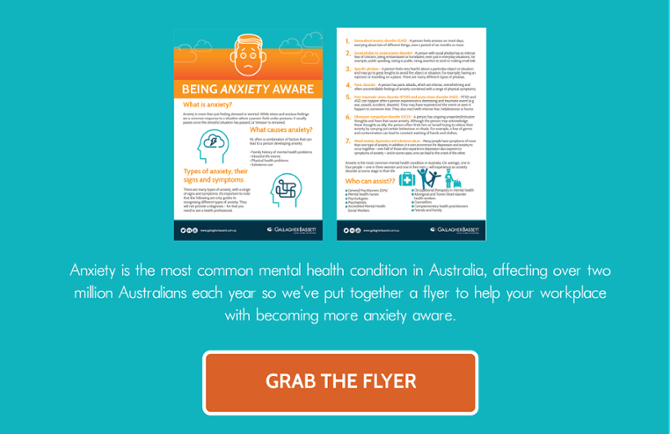Anxiety in the workplace - education, awareness and advocacy

Anxiety is the most common mental health condition in Australia, affecting over two million Australians each year – we’re taking a closer look how we can work to improve mental health awareness and management at work.
What does anxiety look like
According to beyondblue anxiety is more than just feeling stressed or worried. Anxiety is when anxious feelings don't go away – when they're ongoing and happen without any particular reason or cause. Stress and anxiety at work can often lead to other serious health issues such as burnout.
It is important to note that there are also different types of anxiety. While many people with anxiety experience symptoms of more than one type of anxiety condition some symptoms include withdrawing or avoiding situations and people for fear of being criticised, embarrassed or humiliated. Shortness of breath, heart palpitations, difficulty sleeping and trouble concentrating are also signs that someone is experiencing serious anxiety
The most common types of anxiety are:
Other conditions where anxiety is present include:
Obsessive compulsive disorder (OCD)
Post- traumatic stress disorder (PTSD
Mental illness doesnt discriminate
According to Diversity Council Australia (DCA) one in three women will experience anxiety at some stage in their life while it affects one in five men.
With one in seven Australians experiencing discrimination because of their culture or ethnicity, which can cause psychological distress, anxiety and depression, those from diverse cultural groups can be more likely to suffer anxiety.
Mental health support services have recently reported a significant increase in demand from members of the LGBTIQ+ community.
Being a Support System
We recently wrote some tips for how employers can build a mentally healthy workplace but Heads Up and beyondblue make the following suggestions for helping someone suffering anxiety:
- Let them know if you’ve noticed a change in their behaviour
- Spend time talking about their experiences and let them know that you’re there to listen without being judgmental
- Help them to get information from a website, library or community health centre
- Suggest they go to a doctor or health professional, and help them to make an appointment
- Offer to go with them to their appointment and/or follow them up afterwards
- Encourage them to get enough sleep, exercise and to eat well
- Encourage family and friends to invite them out and keep in touch, but don’t pressure them to participate in activities
- Encourage the person to face their fears with support from their doctor/psychologist
- Discourage them from using alcohol or other drugs to try to feel better
- Contact a doctor or hospital if they become a threat to themselves or others.
We've created a flyer for you to download, print and use in your workplace in efforts to create a more 'anxiety aware' workplace.

If you would like to have a discussion with GB about what action plans are available to improve the mental health and wellbeing of your workplace, contact us today.
